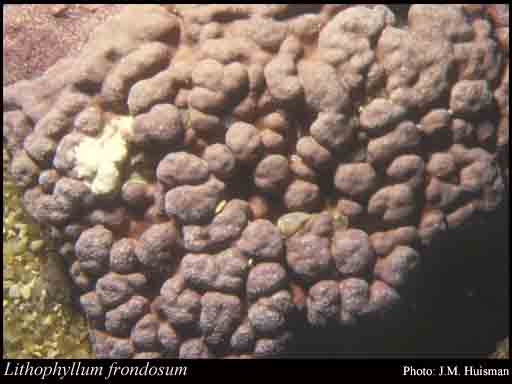- Reference
- Eur.J.Phycol. 115 (1996)
- Conservation Code
- Not threatened
- Naturalised Status
- Native to Western Australia
- Name Status
- Current

Scientific Description
Habit and structure. Thallus normally pinkish, encrusting to layered, foliose, warty, lumpy or fruticose, mostly 4–200 mm across and 0.1–60 mm thick or tall, partially to completely affixed by cell adhesion or unattached and free-living as rhodoliths; protuberant branches simple or branched, mostly 2–27 mm in diameter and 2–29 mm long; lamellate branches applanate or ascending and sometimes coalescent, mostly 3–12 mm across and 1–8 mm long. Structure pseudoparenchymatous, organisation dorsiventral in crustose portions and lamellate branches but radial in protuberant branches; construction dimerous, dimerous and monomerous or largely monomerous; dimerous portions consisting of a single ventral layer of branched, laterally cohering, filaments each composed of palisade and/or non-palisade cells 5–25 µm long and (16–)25–60(–100) µm high, and additionally of simple or branched, laterally cohering, filaments that arise dorsally and more or less perpendicularly from cells of ventral layer filaments and are each usually composed of cells 3–15 µm in diameter and (3–)8–50(–60) µm long; monomerous portions consisting of a single system of branched, laterally cohering, filaments that collectively contribute to a ventrally or centrally situated core and a peripheral region where portions of core filaments or their derivatives curve outwards towards the thallus surface, with each filament composed of cells 5–14 µm in diameter and 5–50(–70) µm long; epithallial cells 4–12 µm in diameter and 2–6 µm long, terminating most filaments at the thallus surface, with distal walls rounded or flattened but not flared; cells of adjacent filaments joined by secondary pit-connections; cell-fusions, haustoria, and trichocytes unknown.
Reproduction.Vegetative reproduction by thallus fragmentation. Gametangia, carposporangia and tetrasporangia produced in uniporate conceptacles; gametangia and carposporangia formed on thalli separate to those bearing tetrasporangia. Bisporangia unknown. Gametangial thalli probably dioecious. Carpogonia terminating 2- or 3-celled filaments arising from the female conceptacle chamber floor. Mature female-carposporangial conceptacle roofs flush with or slightly protruding above surrounding thallus surface, 65–110 µm thick, composed of 7–11 layers of cells above the chamber, conceptacle chambers (169–)300–385 µm in diameter and (65–)85–115(–125) µm high. Carposporophytes composed of a conspicuous central fusion cell and several-celled gonimoblast filaments bearing terminal (rarely catenate) carposporangia 30–55 µm in diameter. Spermatangial filaments unbranched, borne in groups of 1–3 on initials across the male conceptacle chamber floor, mature male conceptacle roofs flush with or slightly protruding above surrounding thallus surface, 18–40 µm thick, composed of 4–5 layers of cells above the chamber, male conceptacle chambers (100–)140–160 µm in diameter and 25–60 µm high. Tetrasporangial conceptacle roofs non- or slightly protruding above surrounding surface, mostly 3–7 cells thick above chamber, pore canals lined with somewhat projecting cells that do not completely occlude the canal, conceptacle chambers (255–)320–410(–445) µm in diameter and (65–)90–125(–160) µm high, floor of mature chambers usually 7 or more cells below thallus surface; tetrasporangia scattered across the conceptacle chamber floor or peripheral to a central columella, each mature sporangium 25–45(–55) µm in diameter and (31–)75–125(–135) µm long, containing zonately arranged tetraspores.
Distribution.Mediterranean Sea; Bermuda; Florida; Caribbean islands; Juan Fernandez I. In Australia, Eagle Bluff, Shark Bay, W. Aust., to Newport, N.S.W., and from the northern and eastern coasts of Tas.
Habitat. L. frondosum has been found in southern Australia on rock, or occasionally on molluscs, algae or seagrasses or unattached; it occurs in intertidal pools and along reef edges in heavy surf and subtidally to depths of 13 m.
[After Womersley, Mar. Benthic Fl. Southern Australia IIIB: 233–237 (1996)]